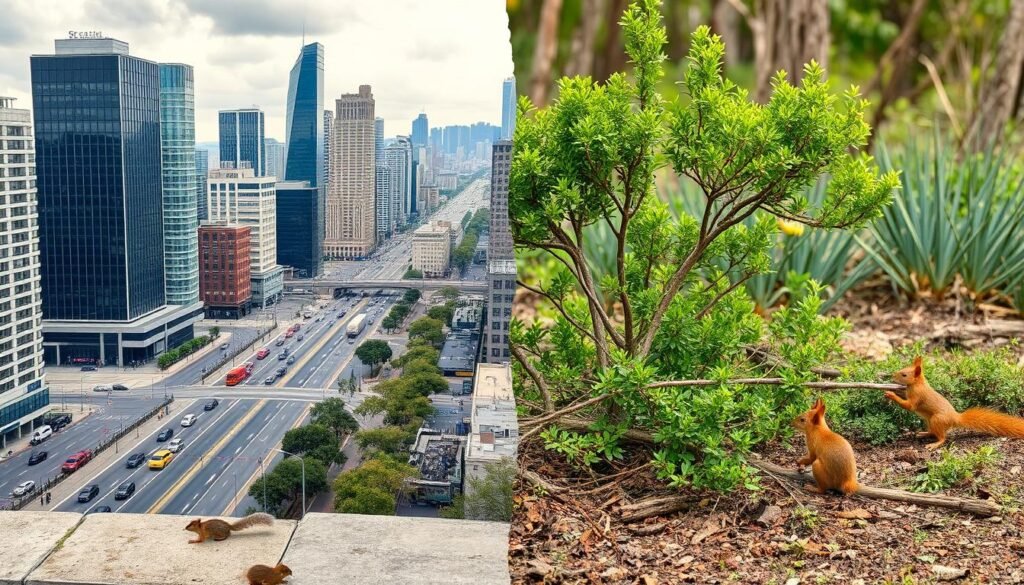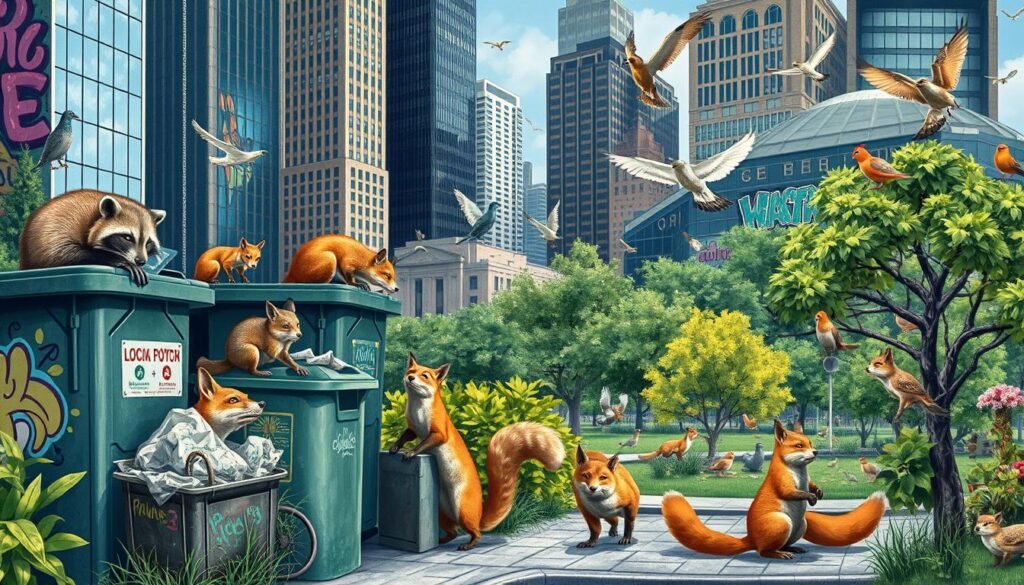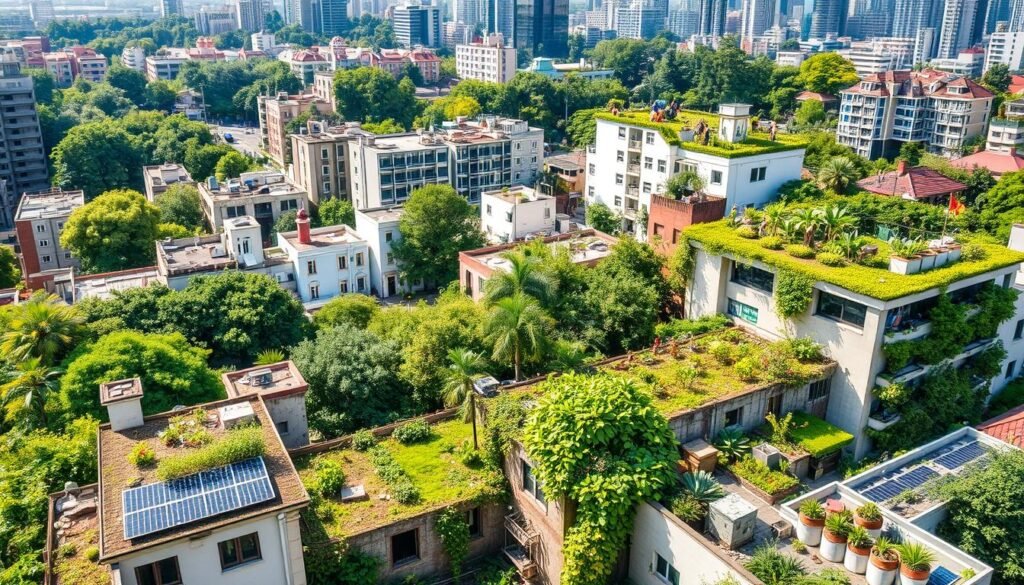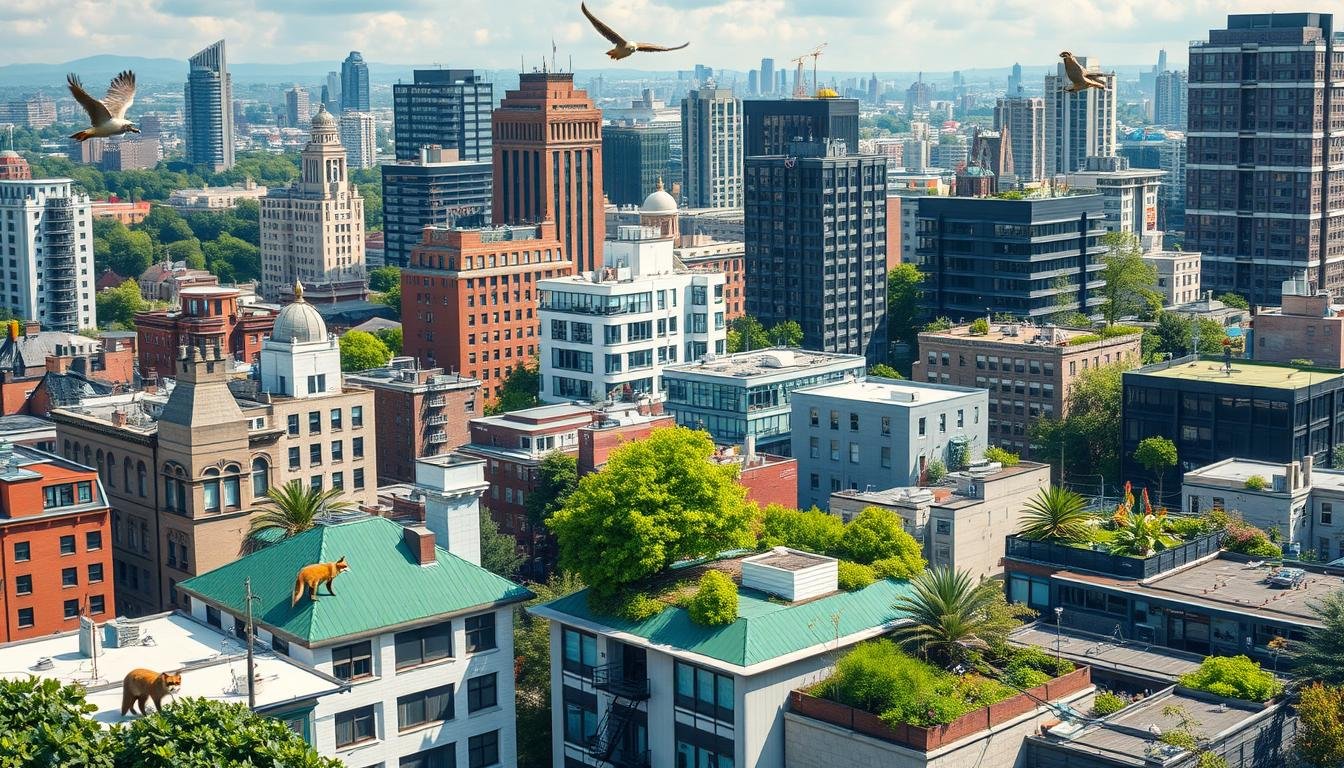The United States is getting more urban, with 80 percent of people living in or near cities. This makes it crucial to connect city dwellers with nature. The U.S. Fish and Wildlife Service is working hard, giving $7.7 million each year for urban wildlife conservation. They have 101 urban national wildlife refuges close to big cities, and 8 flagship refuges. This shows cities are key for biodiversity and wildlife conservation.
Studies have shown cities are home to more than just pigeons and squirrels. In New York City, for example, bobcats and snowy owls have been found. Coyotes are also doing well in cities. These urban ecosystems are vital for endangered species and help with biodiversity.
Key Takeaways
- Cities are increasingly recognized as important habitats for wildlife conservation, with diverse species adapting to urban environments.
- The U.S. Fish and Wildlife Service allocates significant funding to support local solutions for urban wildlife conservation.
- Urban national wildlife refuges and partnerships provide access to green spaces and outdoor recreation for urban residents, fostering connections between people and nature.
- Urban ecosystems can provide refuge for threatened species and contribute to regional biodiversity, challenging the perception that cities lack wildlife.
- Researchers work with city planners and urban wildlife managers to make cities part of the solution to the global biodiversity crisis.
Also Read : The Role Of Animal Nutrition In Enhancing Immune System Function
Understanding Urban Ecosystems and Biodiversity
As more people move to cities, it’s key to grasp the complex urban ecosystems. Over half of humanity now lives in cities. In Oregon, cities cover about 6% of the land, with 75% of people living in big cities.
Cities like Portland are leaders in urban planning. They show how important it is to keep and improve urban habitats.
Also Read : Simple Wellness Habits For A Balanced And Healthy Life
Types of Urban Habitats and Their Importance
Urban ecosystems include parks, backyards, cemeteries, and wetlands. These spots are vital for native species and wildlife populations. They act as essential urban habitats for many plants and animals.
Keeping and growing these urban ecology spots is crucial for urban biodiversity.
Natural Areas Within City Limits
Cities have key natural areas that help fish and wildlife. These natural areas are vital for urban ecosystems. They offer important services to the community.
It’s essential to protect and improve these natural spaces in urban planning and conservation.
Also Read : The Ultimate Guide To Designing A Balanced Lifestyle Routine
Role of Green Infrastructure
Green infrastructure, like green roofs and tree canopies, brings many benefits. These green infrastructure elements help urban ecosystems stay healthy. They boost urban biodiversity and improve city life.
“Urban ecosystems are rich in biodiversity and provide critical natural capital for climate change adaptation and mitigation.”
The Rise of Urban Wildlife
The world is getting more urban, with more people in cities than ever. Yet, a surprising thing is happening – urban wildlife is thriving. Studies show that cities can have diverse and healthy wildlife communities.
Coyotes, for example, are now common in U.S. cities, avoiding humans well. Flying squirrels and otters have also made a comeback in Chicago. Even birds like peregrine falcons do better in cities than in the countryside.
Also Read : Healthy Quick Recipes For Fast And Nutritious Meals
A 2017 study found 66 bird species live only in cities. Native bees in cities are also more diverse than in rural areas. This is seen as a big win for urban wildlife conservation.
Why is this happening? Cities are becoming better homes for wildlife, offering food and safety. Habitat loss and climate change also push species into cities.
But, more wildlife in cities brings challenges. Conflicts like coyotes taking pets during wildfires or monkeys stealing food in Hong Kong are rising. We need more research to help manage these issues.
As cities grow, protecting urban wildlife is key. We must create wildlife-friendly spaces and engage communities. This will help us live peacefully with our urban wildlife neighbors.
Also Read : Quick And Easy Cooking Recipes For Busy Weeknights
Challenges Facing City-Dwelling Species

Urban growth poses big challenges for city animals. One major problem is habitat fragmentation and loss. As cities spread, natural habitats get destroyed and split. This leaves animals with little room to live.
Urban areas also cause human-wildlife conflicts. People and animals get too close, leading to fights over space and safety. Animals may get hurt or killed by humans, pets, and buildings. Also, invasive species can push out native animals, upsetting the balance of urban ecosystems.
The effects of urban growth go beyond just changing the environment. Pollutants, noise, and artificial lights harm urban animals. These stressors make it hard for them to survive and thrive.
Yet, cities are trying to help urban animals. By using smart wildlife management and teaching people, cities aim for a better life for both humans and animals.
| Challenge | Impact on Urban Wildlife |
|---|---|
| Habitat Fragmentation and Loss | Destruction and division of natural habitats, limited areas for wildlife to thrive |
| Human-Wildlife Conflicts | Clashes over resources, territory, and safety, leading to displacement, injury, or death |
| Invasive Species | Outcompeting native species and disrupting the balance of urban ecosystems |
| Urban Development Impacts | Pollutants, noise, and artificial lighting affecting wildlife behavior, reproduction, and health |
“Effective management and planning in urban and suburban areas are complex due to social, economic, cultural, and regulatory factors.”
Urban Wildlife: Species Adapting to City Life

As cities grow, many urban animals have learned to live well in the urban jungle. These adapted to urban species have found new ways to survive and even thrive in cities. They show how nature can adapt to fast-changing environments.
Coyotes, raccoons, and squirrels are great examples of urban animals. They’ve made cities their home, using the food and shelter cities offer. This shows how well animals can adjust to city life.
Peregrine falcons, once on the brink of extinction, now live in cities thanks to man-made nests. The Streaked Horned Lark, once threatened, now mostly lives in cities and farmland.
Painted turtles are common in cities, using urban waterways as their home. Birds like Cooper’s hawks and Mississippi kites also do well in cities, thanks to the abundance of food.
| Species | Adaptation to Urban Environments |
|---|---|
| Coyotes | Established territories within city limits, taking advantage of abundant food sources and nesting opportunities. |
| Raccoons | Successfully integrated into urban ecosystems, adapting to the availability of food and nesting sites. |
| Squirrels | Thrived in urban environments, utilizing the resources and opportunities presented by the city. |
| Peregrine Falcons | Experienced a remarkable comeback by utilizing artificial nesting structures on bridges and buildings in cities. |
| Streaked Horned Lark | A threatened species that is now found primarily in urban and agricultural habitats. |
| Painted Turtles | Established significant populations in urban waterbodies, finding refuge in the city. |
| Cooper’s Hawks | Thrived in urban areas due to the higher prey density, becoming a common urban raptor. |
| Mississippi Kites | Adapted to the urban environment and its abundant food sources, becoming a successful urban raptor. |
These examples show how well urban animals can adapt and thrive in cities. They prove that nature can be resilient even in the face of rapid change.
Conservation Strategies in Urban Environments

More than 55% of people now live in cities. This makes it crucial to protect nature in urban areas. Conservation biology helps keep natural habitats safe in cities, letting people and wildlife live together.
Green Space Planning and Management
Cities like Eugene and Corvallis in Oregon are creating green spaces. These areas provide homes for wildlife and connect parks. The Intertwine Alliance in Portland/Vancouver is working on a big network of parks and trails.
Wildlife Corridors and Connectivity
Creating wildlife corridors is key in cities. These paths help animals move between areas. New ideas are being tried to overcome challenges like land ownership.
Community Engagement Programs
Getting people involved is important for conservation. Programs like the Audubon Society of Portland encourage people to make their yards wildlife-friendly. This helps conservation efforts grow.
As cities grow, we need new ways to protect nature. Green spaces, wildlife corridors, and community programs are essential. They help cities and nature work together.
| Key Urban Conservation Strategies | Benefits |
|---|---|
| Green Space Planning and Management | Provides vital habitat and connectivity for local wildlife within cities |
| Wildlife Corridors and Connectivity | Allows wildlife to adapt to changing climates and move freely between habitats, preventing genetic isolation |
| Community Engagement Programs | Encourages residents to create wildlife-friendly spaces and builds public support for conservation efforts |
Also Read : Top 10 Dog Training Advice Tips For Happy Dogs
Success Stories in Urban Wildlife Protection
The Urban Wildlife Conservation Program has helped create 101 urban national wildlife refuges. These are within 25 miles of big cities across the United States. The program also has 32 Urban Wildlife Refuge Partnership cities and 30 Urban Bird Treaty cities. This shows a big commitment to protecting wildlife in cities.
With an annual budget of $7.7 million, the program is making a big difference. It’s helping to save and grow different species in cities.
One big success is the Peregrine Falcon. It was once in danger but is now safe thanks to living in cities. The Eugene area is also a key place for many endangered prairie species. This shows how important cities are for protecting wildlife.
These wins show we’re making progress in protecting wildlife in cities. Conservation efforts are making cities more natural. By using new ideas and working with local people, the program is helping cities and nature live together. This benefits both people and animals.





